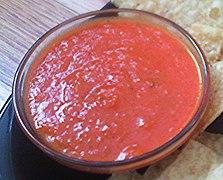Cookbook:Salsa
| Salsa | |
|---|---|
 | |
| Category | Condiments |
Cookbook | Recipes | Ingredients | Equipment | Techniques | Cookbook Disambiguation Pages | Ingredients
Salsa (literally "sauce") refers to a variety of condiments associated with Latin American and Spanish cuisine. It has been claimed to originate in the cuisines of the Inca, Aztec, and Maya cultures.
Characteristics
[edit | edit source]There exists a wide range of salsas, with varying characteristics. They all tend to be spicy fruit/vegetable-based condiments, but they differ in composition and method of preparation. Many salsas in the United States contain tomatoes, onions, garlic, chiles, and lime or vinegar. Other varieties may include papaya, mango, plantain, corn, beans, bell pepper, peaches, and more. They are often seasoned with cumin and cilantro. Salsas may be cooked or fresh, thick or thin, smooth to coarse in texture, mild to hot in spice levels, smoky, and/or sweet.
Types
[edit | edit source]Fruit salsa
[edit | edit source]Fruit salsas are typically fresh, chunky, spicy salsas featuring a range of fruits other than/in addition to tomato. These can include mango, pineapple, melon, papaya, grape, and more. They are sweet and refreshing.
Picante salsa
[edit | edit source]Picante salsa in the US is a red, tomato-based salsa containing onions and chiles. It tends to be smoother and more finely-chopped rather than chunky. It should not be confused with the Mexican salsa picante, which is more akin to a hot sauce.
Pico de gallo
[edit | edit source]Pico de gallo is a fresh salsa (sometimes accordingly called salsa fresca) made of rough-chopped tomatoes, chiles, onions, cilantro, and lime juice. Because it is raw and chunky, it has a lively assortment of colors.
Salsa de aguacate
[edit | edit source]Salsa de aguacate is a smooth salsa made of avocados, tomatillos, and chiles (often serrano). It is creamy and smooth, almost always served raw. Although it contains avocado, it should not be confused with guacamole.
Salsa roja
[edit | edit source]Salsa roja, or red salsa, tends to contain red tomatoes, red chiles, and onions. It can be raw or cooked, and the consistency can be smooth or chunky. It is very common in United States grocery stores, and many in the US will think of salsa roja as "generic" salsa.
Salsa taquera
[edit | edit source]Taco salsa is a variety of smooth and spicy tomato salsa. It features spicy peppers and is often used as an accompaniment to tacos.
Salsa verde
[edit | edit source]Salsa verde, or green salsa, is a Mexican salsa variety made of tomatillos and green chiles. It may also include onion and cilantro. It has a bright flavor and smooth texture, and it can be cooked or raw. Because of the high acidity in tomatillos, this salsa tends not to need an additional acid.
- Salsa varieties
-
Salsa verde
-
Pico de gallo
-
Salsa roja
-
Salsa verde
-
Pico de gallo
-
Jarred picante salsa
Production
[edit | edit source]Salsa is traditionally made with a mortar and pestle or molcajete, which allows the ingredients to be ground together to the desired consistency. Salsas may also be chopped by hand or puréed in a blender or food processor. Fresh salsas should be allowed to sit for a short period to allow the flavors to meld, then eaten as soon as possible.
Use
[edit | edit source]Salsas can be served with a wide variety of foods. They commonly accompany Mexican and Tex-Mex dishes in the United States, such as burritos, tacos, enchiladas, quesadillas, eggs, and more. They are also often served as a dip with chips.
Recipes
[edit | edit source]- Salsa
- Salsa (Fermented)
- Anchovy Herb Salsa Verde
- Eärgon Salsa
- California Fusion Peach Salsa
- Creamy Aioli Salsa
- Mango Avocado Salsa
- Pico de Gallo
See also
[edit | edit source]External links
[edit | edit source]- https://www.masterclass.com/articles/picante-vs-salsa-explained
- https://www.masterclass.com/articles/pico-de-gallo-vs-salsa-explained
- https://dressings-sauces.org/what-is-salsa/
- https://www.nytimes.com/2007/09/19/dining/19mini.html
- https://www.collinsdictionary.com/us/dictionary/english/salsa
- https://dictionary.cambridge.org/us/dictionary/english/salsa
- https://www.greedygourmet.com/this-vs-that/chutney-vs-salsa/
- https://performancefoodservice.com/get-inspired/salsa-not-just-a-sauce
- https://www.webstaurantstore.com/blog/3596/salsa-types.html
- https://www.delightedcooking.com/what-is-salsa.htm
- https://www.recipetips.com/glossary-term/t--34254/salsa.asp
- https://www.merriam-webster.com/dictionary/salsa





